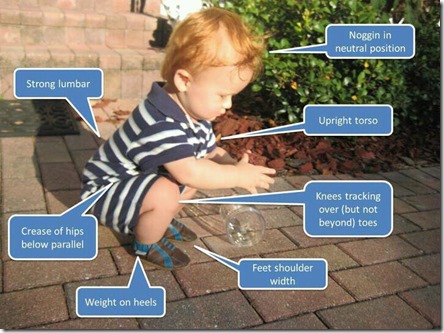Bodyweight Squat/Goblet Squat/FrontSquat
Squatting is extremely natural and before the advent of the chair, was our resting posture. Just watch a baby who is starting to go from crawling to standing, as the mode of transportation. Said infant will be on all fours, big smile, rocking back and forth near a coffee table or something similar. Before you know it, one knee goes down into kneeling, the other up in a lunge and the hands go on the edge of the table. There is a pulling action, yes even babies understand the ‘pull up’ (which we can all do with practice) and the other foot comes underneath the baby as they work to a standing position, and then promptly fall on the bum, maybe a little wail and they’re right back at it. Eventually, they will learn to catch themselves at the bottom and not fall over. Ta-Da, This baby is now sitting in a squat.
Years later, after this tyke goes to school, they will learn to sit a different way, in a stiff chair 🙁 With physical education programs being cut down to almost non-existent, things like Squatting, push-ups and pull-ups get lost in the mix. True Strength is stunted as these movements are all very natural to us and taking them away, limits the combined effects of an academic and physical background. Movement nourishes the brain, as food nourishes the body, furnishing a sensory rich environment and allowing true learning to take place. These things enhance the effects of each other and go hand in hand.
The Goblet Squat is an excellent knee saver, leg strength builder and increases flexibility, by teaching abdominal pressurization. Enjoy the Awesomeness that is: Squatting 🙂
Now, the Squat can be technical, with more loading, single leg squats and the like, but let’s not make it so difficult right now. After all, we already know how to do it. Essentially, you sit down, between your legs in a resting position, ass to heels, with your back straight up and down and a proud chest. The knees do not cave in, rather they point over the little toes and track them. Do not relax at the bottom and the back does not round like a ‘C’ or flex, I merely demonstrated it to show you what not to do.
Maybe you sit at a desk for a living and rarely if ever, see the bottom of a squat position. We can get it back, with this movement. As you can see, my squat is stiff. Major ankle injury and some underlying hip/ankle issues from years of football have robbed me of some mobility. I am working to get it back and I will. As stated, if you have knee flexion issues, tight hips and ankles, this is going to take a little effort on your part to regain the mobility to get here. For me, I’m happy with the progress I’ve made but know there is work to be done. For you, the benefits are many. Squats ARE NOT bad for your knees. Squatting bad is bad for your knees. If you have more serious concerns, Listen to your Body and only go as far as it allows.
Standard Form
- A neutral spine is maintained
- The Heels and toes are planted
- The knees track the toes
- Pause Momentarily on the bottom while staying tight
- Initiate the ascent with a grunt
- The hips ascend at the same rate as the shoulders, not faster
- The hips and knees extend fully on the top of the squat
- Women may not apply pressure to their breasts (hold the bell/s just off chest)
- Neck Remains Neutral
Parallel = the top surface of the leg at the hip joint is lower than the top of the knee
Progressions
- Quadruped Rocking ( Not shown but you do this on all fours, keep big chest and push back into hips, maintain spine alignment)
- Assisted Squat (Dowel rod, doorknobs, suspension straps)
- Bodyweight Squat
- Goblet Squat
- Prying (at the bottom of squat, brace abs for punch, then push knees out slightly and pry knees open)
- Pulling into Squat with Hip Flexors (Imagine pulling your knees to your chest as you sit down, bracing the abs and engaging the hip flexors)
- Front Squat ( Clean 2 bells and Squat, standard form still applies)
Beginner’s Programming:
- Do 1 Repetition of the first progression well, and then the next, etc.
- Practice a progression at a time and move on when it feels appropriate, you will know.
- If you feel you could do 50 clean repetitions of a progression, try another. Just do 50 sets of 1.
- Do Not Rush, Do Not get ‘Tired or Fatigued’ – Just get Better at the movement.
- A few reps here and there of just one step, then piece it together
- A good goal is to work the progressions until you can sit in a comfortable bodyweight squat and then use the goblet squat to find some more mobility.
- Focus on proper alignment and just go as far as the body will allow
- And eat clean, like meat, veggies and fruits….and tell me how you feel below in the comments section below 🙂

